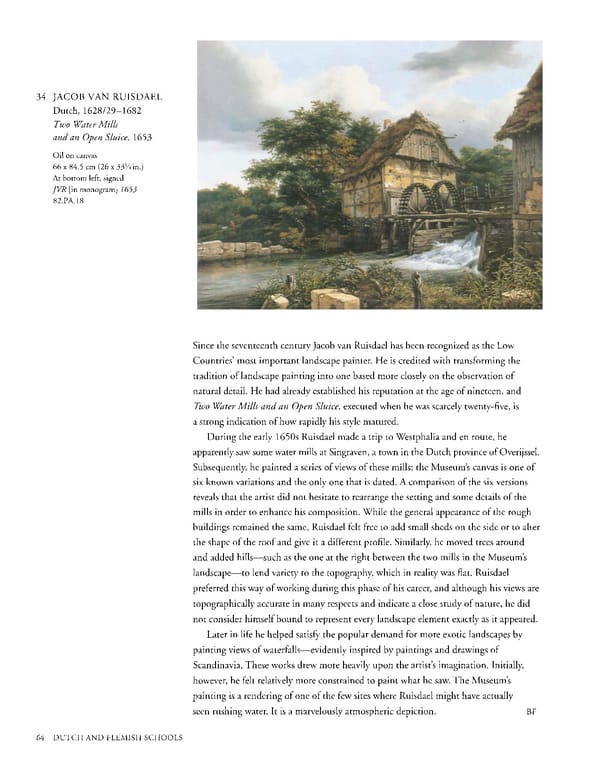34 JACOB VAN RUISDAEL Dutch, 1628/29-1682 Two Water Mills and an Open Sluice, 1653 Oil on canvas 66 x 84.5 cm (26 x 33¼ in.) At bottom left, signed JVR [in monogram] 1653 82.PA.18 Since the seventeenth century Jacob van Ruisdael has been recognized as the Low Countries' most important landscape painter. He is credited with transforming the tradition of landscape painting into one based more closely on the observation of natural detail. He had already established his reputation at the age of nineteen, and Two Water Mills and an Open Sluice, executed when he was scarcely twenty-five, is a strong indication of how rapidly his style matured. During the early 1650s Ruisdael made a trip to Westphalia and en route, he apparently saw some water mills at Singraven, a town in the Dutch province of Overijssel. Subsequently, he painted a series of views of these mills; the Museum's canvas is one of six known variations and the only one that is dated. A comparison of the six versions reveals that the artist did not hesitate to rearrange the setting and some details of the mills in order to enhance his composition. While the general appearance of the rough buildings remained the same, Ruisdael felt free to add small sheds on the side or to alter the shape of the roof and give it a different profile. Similarly, he moved trees around and added hills—such as the one at the right between the two mills in the Museum's landscape—to lend variety to the topography, which in reality was flat. Ruisdael preferred this way of working during this phase of his career, and although his views are topographically accurate in many respects and indicate a close study of nature, he did not consider himself bound to represent every landscape element exactly as it appeared. Later in life he helped satisfy the popular demand for more exotic landscapes by painting views of waterfalls—evidently inspired by paintings and drawings of Scandinavia. These works drew more heavily upon the artist's imagination. Initially, however, he felt relatively more constrained to paint what he saw. The Museum's painting is a rendering of one of the few sites where Ruisdael might have actually seen rushing water. It is a marvelously atmospheric depiction. BF 64 DUTCH AND FLEMISH SCHOOLS
 Masterpieces of the Getty Museum: Paintings Page 64 Page 66
Masterpieces of the Getty Museum: Paintings Page 64 Page 66